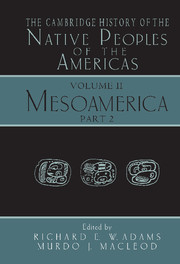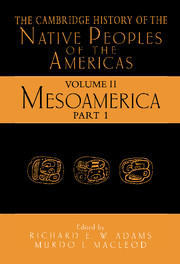29 results
The Aymara Of The Bolivian Andes: A Review of Six Films
-
- Journal:
- Latin American Research Review / Volume 11 / Issue 1 / 1976
- Published online by Cambridge University Press:
- 24 October 2022, pp. 228-232
-
- Article
-
- You have access
- Export citation
Material Life, Continuities, and Periodization: A Comment
-
- Journal:
- Latin American Research Review / Volume 20 / Issue 1 / 1985
- Published online by Cambridge University Press:
- 12 October 2022, pp. 167-170
-
- Article
-
- You have access
- Export citation
Xabier Lamikiz, Trade and Trust in the Eighteenth-Century Atlantic World: Spanish Merchants and their Overseas Networks. The Boydell Press and The Royal Historical Society: Woodbridge, Suffolk, 2010. xi+211 pp. Maps. Tables. Index. ISBN 0861933060 (hbk.). $90.00.
-
- Journal:
- Itinerario / Volume 35 / Issue 2 / August 2011
- Published online by Cambridge University Press:
- 18 November 2011, pp. 108-109
- Print publication:
- August 2011
-
- Article
- Export citation
David Bushnell (1923-2010)
-
- Journal:
- The Americas / Volume 67 / Issue 3 / January 2011
- Published online by Cambridge University Press:
- 17 February 2015, pp. 407-408
- Print publication:
- January 2011
-
- Article
-
- You have access
- Export citation
Carolyn Hall and Héctor Pérez Brignoli with John V. Cotter (cartographer), Historical Atlas of Central America (Norman, OK: University of Oklahoma Press, 2003), pp. xiv+321, $99.95, hb.
-
- Journal:
- Journal of Latin American Studies / Volume 36 / Issue 3 / August 2004
- Published online by Cambridge University Press:
- 05 August 2004, pp. 588-590
- Print publication:
- August 2004
-
- Article
- Export citation
Robert W. Patch, Maya Revolt and Revolution in the Eighteenth Century. Armonk, NY: M.E. Sharpe, 2002. xx + 248 pp. ISBN 0-7656-0412-4.
-
- Journal:
- Itinerario / Volume 27 / Issue 3-4 / November 2003
- Published online by Cambridge University Press:
- 22 June 2011, pp. 323-326
- Print publication:
- November 2003
-
- Article
- Export citation
James Lockhart, Of Things of the Indies: Essays Old and New in Early Latin American History (Stanford, CA: Stanford University Press, 2000), pp. xii+397, $60.00, $22.95 pb; £37.50, £13.95 pb.
-
- Journal:
- Journal of Latin American Studies / Volume 33 / Issue 4 / November 2001
- Published online by Cambridge University Press:
- 20 June 2002, pp. 867-916
- Print publication:
- November 2001
-
- Article
- Export citation
Contents
-
- Book:
- The Cambridge History of the Native Peoples of the Americas
- Published online:
- 28 March 2008
- Print publication:
- 13 April 2000, pp v-viii
-
- Chapter
- Export citation
Frontmatter
-
- Book:
- The Cambridge History of the Native Peoples of the Americas
- Published online:
- 28 March 2008
- Print publication:
- 13 April 2000, pp i-iv
-
- Chapter
- Export citation
Frontmatter
-
- Book:
- The Cambridge History of the Native Peoples of the Americas
- Published online:
- 28 March 2008
- Print publication:
- 13 April 2000, pp i-xvi
-
- Chapter
- Export citation
Part I
-
- Book:
- The Cambridge History of the Native Peoples of the Americas
- Published online:
- 28 March 2008
- Print publication:
- 13 April 2000, pp 1-1
-
- Chapter
- Export citation

The Cambridge History of the Native Peoples of the Americas
-
- Published online:
- 28 March 2008
- Print publication:
- 13 April 2000
Map 12.1: A general map of Mesoamerica, showing major ancient, colonial, and modern population centers"
-
- Book:
- The Cambridge History of the Native Peoples of the Americas
- Published online:
- 28 March 2008
- Print publication:
- 13 April 2000, pp -
-
- Chapter
- Export citation

The Cambridge History of the Native Peoples of the Americas
-
- Published online:
- 28 March 2008
- Print publication:
- 13 April 2000
Index
-
- Book:
- The Cambridge History of the Native Peoples of the Americas
- Published online:
- 28 March 2008
- Print publication:
- 13 April 2000, pp 559-571
-
- Chapter
- Export citation
Index to Part 2
-
- Book:
- The Cambridge History of the Native Peoples of the Americas
- Published online:
- 28 March 2008
- Print publication:
- 13 April 2000, pp 445-455
-
- Chapter
- Export citation
List of Illustrations
-
- Book:
- The Cambridge History of the Native Peoples of the Americas
- Published online:
- 28 March 2008
- Print publication:
- 13 April 2000, pp ix-xvi
-
- Chapter
- Export citation
Las nuevas memorias del Capitán Jean de Monségur. Jean-Pierre Berthe, ed. (Mexico, D.F.: Instituto de Investigaciones Históricas, 1994. Pp. 225. Illustrations. No Price.)
-
- Journal:
- The Americas / Volume 53 / Issue 2 / October 1996
- Published online by Cambridge University Press:
- 11 December 2015, pp. 305-306
- Print publication:
- October 1996
-
- Article
- Export citation
Conjonctures Opposées: La “Crise” du XVIIe Siècle en Europe et an Amérique Iberique. By Ruggiero Romano. [Publications du Centre D'Histoire Economique Internationale de L'Université de Genève, No. 9.] (Genève: Université de Genève, 1992. Pp. xii, 239. Illustrations. Index. 66 Swiss francs.)
-
- Journal:
- The Americas / Volume 51 / Issue 1 / July 1994
- Published online by Cambridge University Press:
- 11 December 2015, pp. 115-116
- Print publication:
- July 1994
-
- Article
- Export citation
Vingt Etudes sur le Mexique et le Guatemala: Réunies à la mémoire de Nicole Percheron. By Alain Breton, Jean-Pierre Berthe, and Sylvie Lecoin. [Collection Hespérides.] (Toulouse: Presses Universitaires du Mirail-Toulouse, 1991. Pp. 381. Maps. Tables. Figures. References. No price.)
-
- Journal:
- The Americas / Volume 50 / Issue 3 / January 1994
- Published online by Cambridge University Press:
- 11 December 2015, pp. 450-451
- Print publication:
- January 1994
-
- Article
- Export citation

